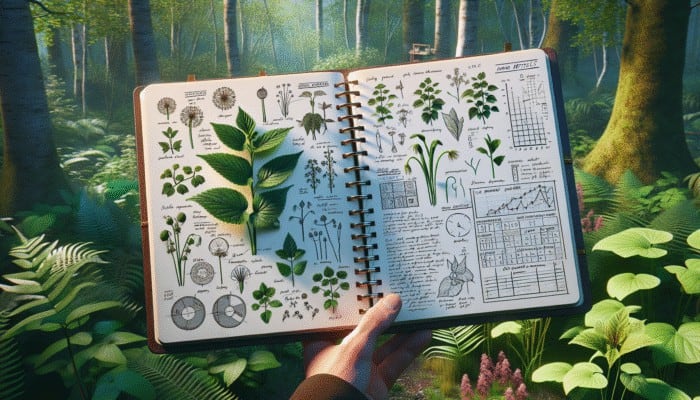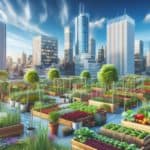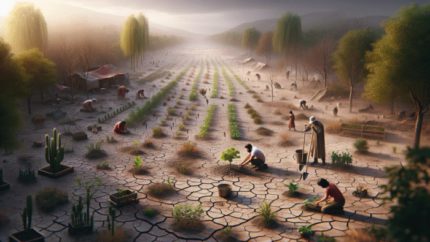Master the Art of Identifying Edible Plants for Foraging
Foraging Safety Tips: Engaging in the enriching practice of foraging not only fosters a deep connection with the natural world but also expands your culinary capabilities. The initial and most crucial step in this rewarding journey is to accurately identify edible plants, which is essential for ensuring your safety. By becoming well-acquainted with the distinctive characteristics of safe flora, you will empower yourself to forage with confidence and proficiency, allowing you to discover the diverse flavours and nutritional benefits of wild edibles.
Utilise Trusted Resources for Plant Identification

The cornerstone of safe and successful foraging lies in the use of reliable resources. Comprehensive field guides are indispensable tools for anyone interested in exploring the fascinating realm of wild edibles. Seek out guides tailored to your specific region, as they will offer in-depth insights into the local flora and their characteristics. Furthermore, online databases and mobile applications can serve as helpful visual aids; however, these should be used judiciously and complemented with printed materials for accuracy. Connecting with botany experts or joining local foraging groups can provide you with invaluable knowledge from seasoned mentors. They can share their experiences, practical tips, and techniques that will enhance your foraging abilities. Notably, organisations such as the National Audubon Society and local agricultural extensions frequently offer plant identification workshops that can be instrumental in your educational journey.
Pay Close Attention to Distinctive Plant Characteristics
A profound understanding of the specific characteristics of plants is vital for safe foraging practices. Key features to observe include leaf shape, colour, and growth patterns. For example, the leaves of wild garlic are long and slender, while those of lily of the valley, although they may resemble them, are highly toxic. It is crucial to notice details such as the size and arrangement of leaves, the presence of flowers, and the overall growth habit of the plant. Observing seasonal variations also aids in identification; many plants exhibit significantly different appearances during their flowering stage compared to their vegetative state. By cultivating a discerning eye for these attributes, you can significantly reduce the likelihood of mistakenly consuming toxic look-alikes, thereby enhancing your foraging experience.
Exercise Caution and Avoid Unknown Species
When foraging, the guiding principle should always be, “When in doubt, do without.” If there is any uncertainty regarding a plant’s edibility, it is best to refrain from consuming it. Numerous plants have toxic relatives that can lead to severe health issues. For instance, the edible hemlock has a lethal counterpart known as poison hemlock, which is often confused with the former. By developing a robust understanding of the local flora through diligent identification practices, you can significantly mitigate such risks. Establishing a routine of confirming plant identities through multiple trustworthy sources before consumption will ensure a safer and more enjoyable foraging experience.
Conduct Regular Seasonal Checks for Edibility

Plants can exhibit varying characteristics and levels of edibility depending on the season. Certain species, like stinging nettles, are only palatable during their early spring growth stage; as they mature, they may become fibrous and less appealing. Understanding the seasonal fluctuations in plant growth and edibility will guide you in selecting the optimal times for foraging. Keeping a detailed journal of your foraging experiences throughout the seasons can help identify the best periods for future expeditions. In addition, this knowledge will help you plan your foraging trips when specific plants are at their peak, ensuring both maximum enjoyment and safety during your adventures.
Implement Edibility Tests for Unfamiliar Plants
To ensure your safety when encountering unfamiliar plants, the universal edibility test can be a valuable tool for determining their safety. Begin by separating a small portion of the plant and preparing it for consumption. Consume a small amount and wait 24 hours to monitor for any potential adverse reactions. If you experience no signs of nausea, swelling, or other symptoms, you can cautiously increase the quantity consumed. While this method is not infallible, it helps to minimise the risk of toxic reactions. Remember that individual sensitivities can vary widely, so maintaining ongoing vigilance is essential when trying new foraged foods.
Ensure Proper Preparation of Foraged Edibles
Once you have successfully foraged for edible plants, it is imperative to prepare them correctly to guarantee safety and maximise enjoyment. From cleaning and cooking to storing your food, each step is crucial for maintaining food quality and preventing potential health hazards.
Thoroughly Clean Foraged Foods Before Use

The very first step in preparing foraged foods is thorough cleaning. Wild plants can often harbour dirt, insects, and other potential contaminants. Rinse your foraged items under running water, using a soft brush for those with crevices where dirt may be concealed. For leafy greens like dandelion greens, soaking them in cool water can effectively remove any grit. Additionally, it is wise to inspect each item for any signs of mould or pests. Starting with a clean slate not only enhances the taste of your foraged foods but also reduces the risk of foodborne illness, ensuring a delightful dining experience.
Cook Wild Edibles to Ensure Safety and Enhance Flavour
Certain wild edibles necessitate cooking to neutralise toxins or improve digestibility. For example, cooking fiddlehead ferns and morel mushrooms is essential, as they may harbour harmful compounds when consumed raw. Familiarise yourself with recipes specific to the plants you forage; this knowledge will not only secure your safety but also unlock the best flavours in your ingredients. Employing cooking methods such as steaming or sautéing can transform your foraged finds into delectable dishes. Moreover, cooking can enhance the bioavailability of certain nutrients, thereby maximising the health benefits of your harvest.
Implement Safe Storage Techniques for Foraged Foods
Proper storage of foraged foods is crucial for maintaining their freshness and avoiding spoilage. Many wild edibles are highly perishable and require refrigeration to prolong their shelf life. Storing herbs in a glass of water or wrapping them in a damp cloth can help to keep them fresh for extended periods. For longer-term preservation, consider techniques such as drying or freezing. Dehydrating herbs, fruits, and vegetables not only preserves them but also intensifies their flavours. Always label your stored items with the date to help keep track of their freshness and ensure optimal use.
Understand Potential Allergies Related to Foraging
As with any new food, being aware of potential allergies is imperative when foraging. Understanding common allergens and how to test for adverse reactions can significantly enhance your safety when exploring new wild edibles.
Recognise and Avoid Common Food Allergens
When foraging, it is essential to be cognisant of common food allergens. Nuts, berries, and certain plants can trigger allergic reactions in individuals who are sensitive to them. For example, while chestnuts are a delicious wild treat, they can pose a severe risk for anyone with a nut allergy. Conducting thorough research on potential allergens present in your region is crucial, particularly before introducing new foods into your diet. Familiarising yourself with local edibles can help you navigate potential pitfalls while safely expanding your culinary horizons.
Test New Foraged Foods in Small Quantities
When incorporating new foraged foods into your diet, it is wise to proceed with caution. Begin by consuming small amounts of any unfamiliar plant to monitor for possible allergic responses. For instance, if you are sampling wild blueberries for the first time, start with just a few to assess your body’s reaction before indulging in larger quantities. Keeping a detailed record of your experiences in a foraging journal can help you track what you enjoy and what may lead to discomfort. This practice not only enriches your foraging experience but also helps prevent future allergic reactions.
Consult a Medical Professional for Allergy Concerns
If you have any concerns regarding allergies or reactions to foraged foods, seeking advice from a healthcare professional can provide clarity. An allergist can conduct tests to identify specific sensitivities and offer tailored guidance. Moreover, if you experience severe reactions, it is crucial to seek medical attention immediately. Understanding your body’s responses to new foods empowers you to forage safely and enjoyably, with confidence in your choices.
Embrace Environmental Respect While Foraging
Foraging is not merely about gathering food; it also entails respecting the environment that sustains it. Adopting sustainable practices ensures that ecosystems remain healthy and vibrant for future generations.
Adopt Sustainable Harvesting Practices
Sustainable harvesting practices are essential for responsible foraging. Only take what you require and avoid depleting areas of their natural resources. For instance, when foraging for wild asparagus, leave enough behind to support future growth. This approach not only helps maintain healthy plant populations but also promotes biodiversity. By cultivating a mindset focused on sustainability, you ensure that your foraging adventures have a positive impact on the environment rather than contributing to its depletion.
Minimise Your Ecological Impact While Foraging
As you forage, it is important to be mindful of your surroundings. Avoid trampling delicate vegetation and strive to minimise disturbances to wildlife habitats. Where possible, stick to established trails, and consider using tools that reduce your ecological footprint, such as biodegradable containers. Respecting natural habitats is crucial for preserving biodiversity, which is essential for the overall health of ecosystems. By respectfully engaging with nature, you can cultivate a symbiotic relationship that allows both foragers and the environment to flourish.
Adhere to Local Foraging Regulations for Sustainable Practices
Complying with local foraging laws and guidelines is vital for protecting both natural resources and your safety. Different regions have specific regulations concerning foraging times, locations, and allowable quantities. Conduct thorough research on local ordinances before embarking on your foraging adventures, as this knowledge can help you avoid fines and contribute to the conservation of native species. Engaging with the community around foraging regulations fosters a culture of respect and responsibility among fellow enthusiasts, ensuring the sustainability of these practices.
Equip Yourself with the Right Foraging Tools
Having the appropriate tools at your disposal can greatly enhance your foraging experience, making it safer and more efficient. From gathering to storing your finds, the right gear plays a crucial role in successful foraging.
Carry Essential Foraging Gear for Efficiency and Safety
When foraging, it is essential to carry the necessary gear that can streamline the process and enhance your safety. A sturdy basket is ideal for collecting items, as it allows for proper air circulation, preventing the spoilage of your finds. A sharp knife is invaluable for cutting stems or roots, while gloves can protect your hands from thorny plants or potential irritants. Investing in a high-quality field guide is also essential to aid in plant identification while on the move. Additionally, carrying a small first aid kit can provide peace of mind while exploring the great outdoors.
Maintain Your Foraging Equipment for Optimal Performance
Keeping your foraging tools in excellent condition is fundamental for both safety and efficiency. Regularly clean your tools to prevent contamination and rust; this is particularly important for knives and containers that come into contact with food. Sharp tools enhance safety by reducing the likelihood of accidents while foraging. Moreover, inspecting your gear before each outing ensures that you are prepared for whatever challenges the day may present. Proper maintenance of your equipment not only enhances your foraging experience but also extends the lifespan of your tools.
Select Appropriate Containers for Storing Foraged Foods
Choosing the right containers for storing your foraged goods is crucial for maintaining their quality and freshness. Breathable materials, such as woven baskets or cloth bags, allow moisture to escape, thus preventing spoilage. It is advisable to avoid plastic bags, as they can trap moisture and lead to mould growth. If you plan to store wet items, consider using breathable mesh bags or paper. Clearly labelling your containers with the date and contents will help you stay organised and ensure your foraged items remain fresh for use.
Learn from Experienced Foragers for Enhanced Skills
Foraging is an art form that benefits immensely from shared knowledge and expertise. Learning from seasoned foragers can accelerate your understanding and improve safety during your foraging adventures.
Join Local Foraging Groups for Community Learning
Connecting with experienced foragers can provide invaluable insights into best practices and safety tips. Many local communities host foraging clubs or online forums where enthusiasts can share their knowledge and experiences. Participating in group foraging excursions allows for real-time learning, enabling you to ask questions and gain firsthand insights. Building relationships within these communities fosters a supportive environment, exponentially enhancing your foraging skills and confidence.
Participate in Foraging Workshops for Practical Experience
Foraging workshops offer hands-on experiences that can deepen your understanding of wild edibles. Many botanical gardens, nature reserves, and local agricultural extensions host workshops that cover plant identification, preparation, and sustainable harvesting techniques. Engaging in these educational settings allows you to practice in a structured environment under the guidance of experts. Not only do you learn about local plants in detail, but you also gain the confidence to forage safely and effectively.
Expand Your Knowledge Through Educational Foraging Materials
Delving into books and articles authored by foraging experts can significantly broaden your knowledge base. Resources such as “The Forager’s Harvest” by Samuel Thayer offer comprehensive insights into specific plants, including their identification, preparation, and cultural significance. Furthermore, online articles and blogs provide current trends, recipes, and personal anecdotes that can inspire your foraging journey. Dedicating time to study various materials will adequately prepare you for a successful and safe foraging experience.
Stay Informed About Potential Contaminants
While foraging opens a world of culinary possibilities, it is vital to remain aware of potential contaminants that could jeopardise your health. Understanding where to forage and what to avoid is key to ensuring safety during your foraging excursions.
Avoid Foraging in Polluted Areas for Your Health
Foraging in polluted areas can expose you to harmful toxins and contaminants. Steer clear of locations near busy roads, industrial sites, or agricultural fields where pesticides are likely to be prevalent. Urban areas can also pose risks due to potential contamination from human activities. Instead, opt for pristine settings, such as untouched forests or natural reserves, to minimise exposure to pollutants. Researching local areas will help you identify safe foraging spots, ensuring that your finds remain healthy and safe for consumption.
Be Cautious of Pesticide Residues on Foraged Plants
If you are foraging near agricultural zones, exercise caution regarding plants that may have been treated with pesticides or herbicides. These chemicals can persist on plants and pose significant health risks when ingested. Always inquire about local farming practices or seek out areas where organic farming is practised for safer foraging options. Thoroughly washing your foraged items can help eliminate surface residues, but understanding the source of your food is equally crucial for your safety.
Monitor for Heavy Metals in Foraged Plants
Certain plants can absorb heavy metals from the soil, which can accumulate and pose health risks over time. Species such as wild spinach or purslane may absorb lead or cadmium if grown in contaminated soils. If you suspect that your foraging area may be polluted, consider having your finds tested for heavy metal concentrations. Being informed about the environmental conditions where you are foraging can help you make safer choices and avoid potential contamination.
Prepare for Emergencies While Foraging
While foraging, having a comprehensive plan for emergencies can provide an extra layer of reassurance and safety. Accidents and unexpected situations can arise, so being adequately prepared is paramount for a secure experience in the wild.
Always Carry a Well-Stocked First Aid Kit
A well-stocked first aid kit is essential for any foraging trip. Basic supplies such as band-aids, antiseptic wipes, gauze, and adhesive tape can assist in treating minor injuries or allergic reactions. Including items like antihistamines for allergic reactions and a snakebite kit can further enhance your preparedness. Regularly check and replenish your kit to ensure that all items remain current and usable, providing peace of mind during your outdoor adventures.
Learn Basic First Aid Skills for Increased Safety
Acquiring basic first aid skills can be invaluable during foraging excursions. Knowing how to perform CPR, treat wounds, or recognise signs of a stroke or heart attack can save lives in emergencies. Many organisations offer first aid courses that can equip you with these essential skills; this knowledge applies not only to foraging but also to everyday life. Being prepared with such knowledge can enable you to respond effectively to various situations, ensuring a safer outdoor experience.
Establish a Comprehensive Emergency Plan
Developing a family emergency plan is crucial for any outdoor activity, including foraging. This plan should include communication strategies, evacuation routes, and designated meeting points. Familiarize yourself with the area where you will be foraging, and establish a timeframe for your outing to ensure a safe return. Sharing these details with family or friends adds an extra layer of security, allowing them to check on you if necessary, ensuring your well-being during your adventures in nature.
Frequently Asked Questions About Foraging
What are the top resources for identifying edible plants?
Trusted field guides and expert consultations are your best resources for identifying edible plants. Local foraging groups and online databases can also provide valuable information and insights.
How can I determine if a plant is safe for consumption?
Always confirm plant identities through multiple reliable sources, carefully observe their characteristics, and if you’re uncertain, refrain from consuming them.
What should I do if I suspect I have consumed a toxic plant?
Seek immediate medical attention. If possible, bring a sample of the plant with you to assist healthcare professionals with identification.
Are there any plants I should avoid foraging?
Yes, avoid foraging near polluted areas or those treated with pesticides. Additionally, steer clear of species that are known to have toxic relatives to ensure your safety.
How do I store foraged plants safely?
Store foraged plants in breathable containers, such as baskets or cloth bags, to maintain quality and prevent spoilage. Refrigeration may be necessary to prolong the freshness of highly perishable items.
Can I forage in urban areas without concerns?
Yes, however, be cautious of pollution and chemicals. Look for parks or natural areas that are less likely to be contaminated for safer foraging opportunities.
What common allergens should I be aware of while foraging?
Common allergens include nuts, berries, and certain wild plants. Always research potential allergens before introducing new foraged foods into your diet.
How can I participate in foraging workshops?
Check with local agricultural extension offices, botanical gardens, or foraging groups for information on upcoming workshops and events that offer educational opportunities for aspiring foragers.
What is the universal edibility test, and how does it work?
The universal edibility test involves consuming a small portion of a new plant and waiting 24 hours to monitor for any adverse reactions before deciding to eat more of it.
Is foraging legal everywhere?
No, foraging laws vary by region. Always check local regulations and obtain permission if foraging in private areas to avoid legal issues.
Explore our world on X!
Water Filter Comparisons: Your Ultimate Guide
Comprehensive Overview of Water Filter Types Understanding Reverse Osmosis Systems for Optimal Water Purity Water Filter Comparisons: Reverse osmosis (RO) systems are among the most sophisticated technologies available for water filtration. By employing a semipermeable membrane, these systems effectively eliminate a wide range of contaminants, including salts, heavy metals, and microorganisms. The filtration process involves […]
Water Collection Systems: Essential Solutions for Sustainability
Comprehensive Overview of Water Collection Systems What Exactly Are Water Collection Systems? Water Collection Systems: Water collection systems encompass a variety of innovative technologies and methodologies specifically developed to capture, store, and utilise water from diverse sources, with a primary focus on rainwater. These systems are crucial for the sustainable management of water resources, particularly in […]
Portable Water Filters: Essential for Clean Drinking
Comprehensive Guide to Portable Water Filters What Exactly Are Portable Water Filters? Portable Water Filters: Portable water filters are compact and efficient devices engineered to purify water from various sources, ensuring it is safe for consumption. These filters are essential tools for outdoor enthusiasts, travellers, and individuals preparing for emergencies. They provide access to clean […]
Urban Gardening Survival: Thrive in Cities
Key Strategies for Successful Urban Gardening Mastering Soil Management in Urban Settings Urban Gardening Survival: Effectively maintaining healthy soil is paramount for achieving success in any urban garden, particularly when space is limited. Urban settings often present distinct challenges, including compacted soil and a scarcity of organic matter. Gaining a comprehensive understanding of how to […]








The importance of accurately identifying edible plants during foraging cannot be overstated, and I appreciate your emphasis on using trusted resources for this purpose. In my own experience, I have found that the journey of foraging goes beyond simply gathering ingredients; it becomes a transformative practice that deepens my appreciation for the environment. Each outing in the wild is an opportunity not only to learn about the plants themselves but also to engage with the ecosystems they inhabit.
Your point about foraging being a transformative practice resonates. It’s fascinating how just stepping outside with a purpose can shift our perspective. Gathering food isn’t just about nutrition; it’s an act of connection. With each plant we identify, we learn to read the landscape differently.
“I’m glad to hear about your transformative experiences in foraging! If you’re looking to enhance your journey further, check out this resource that offers valuable insights and guidance on safe foraging practices.”
https://survivalbite.com/wild
I completely agree—there’s something deeply profound about foraging that transcends mere sustenance. It’s like a meditation in motion, where each step connects us to the environment and our ancestors in a way that feels ancient yet incredibly relevant. The act of identifying plants not only sharpens our observational skills but also deepens our appreciation for the ecosystems around us.
I really resonate with the importance of learning to identify edible plants for foraging, particularly considering how it ties into a broader appreciation for nature and our food sources. It’s not just about finding something to eat; it’s about cultivating a deeper relationship with the environment around us. I’ve dabbled in foraging for a couple of years now, and it’s truly incredible how much knowledge you can gain just by observing the tiniest details in plants. I remember the first time I confidently identified a few wild edibles—making a salad with dandelion greens felt so rewarding.
This topic really resonates with me! Foraging has become such a fulfilling activity in my life—not just for the fresh ingredients but for that deeper connection to nature. I remember my first experience trying to identify wild garlic. I was so nervous about mistaking it for something harmful, but it was so rewarding to finally find some and incorporate it into a meal.
Ah, the art of foraging! I remember my first attempt at identifying edible plants—let’s just say I ended up with a handful of something that might have been dandelion leaves and a whole lot of uncertainty. Who knew wild edibles could come with that much excitement?
This is a fascinating exploration of foraging and the critical emphasis on plant identification. I can personally attest to the transformative experience of connecting with nature through foraging. It’s more than just a means to gather food; it’s a way to deepen one’s relationship with the environment and to understand the intricate ecosystems around us.
The practice of foraging has always fascinated me, especially considering how it connects us to the rhythms of nature and local ecosystems. Your emphasis on accurately identifying edible plants as the first crucial step resonates deeply with my own experiences in the wild. I remember the first time I ventured out into the woods with a well-thumbed guidebook in hand, feeling an exhilarating mix of excitement and trepidation. The forest seemed to whisper its secrets as I noted the unique leaf structures and vibrant colors of various plants.
This is such a timely reminder that foraging isn’t just a quirky hobby for those of us trying to channel our inner ‘wild’ persona! I’ve dabbled in this art myself, and I can attest to the thrill of identifying an edible plant—only to hesitate over whether that unfamiliar leaf is a tasty treat or a potential ticket to an unexpected trip to the ER. Spoiler alert: I now approach “mystery greens” with significantly more caution.